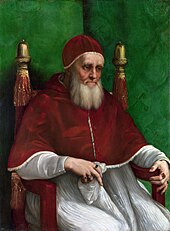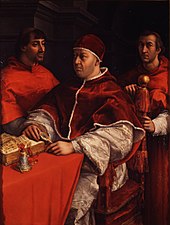Conclave 1513

The conclave of 1513 was the election meeting of the Cardinals after the death of Pope Julius II. And lasted of 4 March 1513 to March 9, 1513. His choice was after 5 days of Giovanni de 'Medici, the Pope Leo X called . According to other sources, he was elected on March 11th.
history
The college of cardinals had 35 members at the beginning of the conclave, but 5 of them had been excommunicated. Another 5 cardinals were not in Rome at the time of the conclave , so that the conclave had 25 participants.
The Cardinals of the Conclave by Nationality:
- Italians: 19 cardinals
- Spaniards: 2 cardinals
- French: 1 cardinal
- Swiss: 1 cardinal
- Hungary: 1 cardinal
- English: 1 cardinal
The conclave, which can be proven to be free of simony , had three candidates, Cardinals Grimani, de'Medici and Carretto, whom the ambassador of Venice described as papabile . They were said to have had a blameless life. The second floor of the Vatican Palace was chosen as the place of conclave, although the elections took place in the Sistine Chapel . The 30 cells were allotted to the cardinals by lot, each of these cells being the size of a prison or hospital cell. Only the Cardinals della Rovere and de'Medici received better accommodation because they were in poor health.
Besides the cardinals, each of whom had two conclavists , there were 55 other people in the conclave. Paris de Grassis and Blasius de Martinellis served as masters of ceremonies, and they also kept the key to the conclave.
After negotiating an election surrender in the first few days, the bull Cum tam divino was read on the fourth day . At that time already divided into two camps, there was the group of the "older" and the "younger". But already in the first few hours the group of the younger cardinals prevailed and elected Cardinal de'Medici.
Since it was normally customary at a conclave to vote in the first round of a candidate who should be honored for his merits but otherwise would not be seriously considered, this also happened in 1513. In this conclave, however, the curiosity arose that about half of all cardinals in the first round of voting had the same candidate in mind, making it almost the most unlikely of the cardinals to become pope.
Attendees
- Cardinal Dean : Raffaele Sansoni Riario
- Cardinal Sub- Dean : Domenico Grimani
- Jaime Serra
- Marco Vigerio O.Min.
- Francesco Soderini
- Alessandro Farnese
- Luis de Aragon
- Tamás Bakócz
- Marco Cornaro
- Francesco Remolino
- Niccoló Fieschi
- Adriano Castellens de Corneto
- Roberto Britto Guibe de Challand
- Leonardo della Rovere Grosso
- Carlo Domenico del Carretto
- Sigismondo Gonzaga
- Sisto Gara della Rovere
- Christopher Bainbridge
- Antonio Maria Ciocchi del Monte
- Pietro Accolti
- Achille de Grassis
- Matthew Schiner
- Bandinello Sauli
- Alfonso Petrucci
- Giovanni de'Medici
Absent cardinals
- Ippolito I. d'Este
- Philip of Luxembourg
- Francois Guillaume de Castelnau-Clermont-Lodévre
- Francisco Jiménez de Cisneros
- Matthäus Lang von Wellenburg


